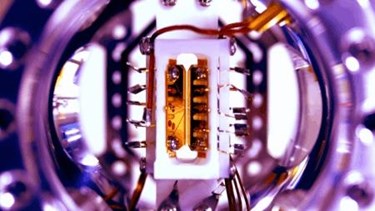Scientists Build First Fully Programmable and Reconfigurable Quantum Computer
By Jof Enriquez,
Follow me on Twitter @jofenriq

Scientists from the University of Maryland have created the world's first fully programmable and reconfigurable quantum computer by using laser beams to manipulate ions to solve complex algorithms faster than any conventional computer.
Today's computers are based on the binary numbering system, zero and one bits representing either an "off" and "on" state at any given time, to store data and perform calculations. Quantum computers use qubits (quantum bits), which exhibit properties of superposition (two states existing at the same time) and entanglement (shared properties). These traits allow quantum computers to solve algorithms beyond the reach of traditional computers.
Other researchers have been able to create small quantum computers capable of solving one particular problem. However, the scientists at the University of Maryland have successfully engineered a new module that is able to run three different basic algorithms by manipulating combinations of ions trapped in a linear chain using an array of tightly-focused laser beams and dedicated detection channels that watch for the glow of each ion.
The re-configurability of the laser beams is a key advantage, stated Shantanu Debnath, graduate student at the university's Joint Quantum Institute.
"By reducing an algorithm into a series of laser pulses that push on the appropriate ions, we can reconfigure the wiring between these qubits from the outside," said Debnath. "It becomes a software problem, and no other quantum computing architecture has this flexibility."
"This flexibility allows Debnath's team to rapidly re-program their computer to solve different problems and run different algorithms," explained Popular Mechanics. "And if they come up with a new algorithm they'd like to run, all they have to do is figure out which atoms need to be entangled and in what order, and then let the lasers do the rest."
To demonstrate the quantum computer's ability to implement arbitrary quantum algorithms by executing any sequence of universal quantum logic gates, they tested the Deutsch–Jozsa and Bernstein–Vazirani algorithms with average success rates of 95 and 90 per cent, respectively, according to their study published in the journal Nature. They also performed a coherent quantum Fourier transform (QFT), a mathematical calculation that could be used to break Internet encryption standards. QFT testing achieved a 70 percent success rate. The researchers claim residual errors do not appear to be fundamentally insurmountable.
The module has five qubits, but could be upgradeable to as many as 100 qubits by linking separate modules, either by physically moving the ions or by using photons to carry information between them, according to a report by the Joint Quantum Institute.
Scalability remains a challenge in quantum computing, although several technology companies are joining the race, notes the Wall Street Journal. D-Wave Systems has a 1,152-qubit system that the company claims to be used by Lockheed Martin and Google, according to the news outlet. Google itself is reportedly working on a prototype quantum computer that features a hybrid architecture using superconducting chips. The same type of chips are utilized by IBM's five-qubit quantum computer, which has been online since May. Intel announced last year a $50 million investment into quantum computing research.
